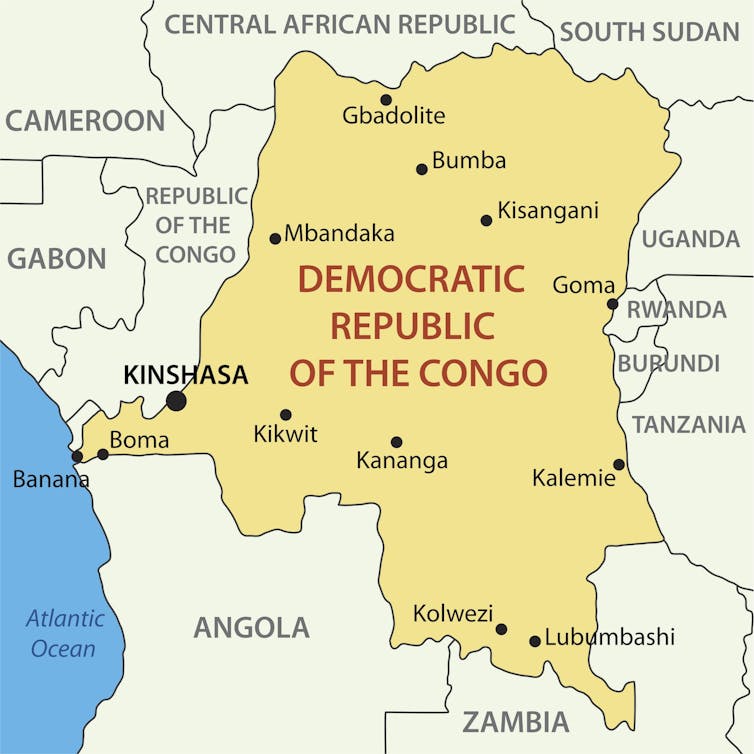Security forces in the Democratic Republic of the Congo (DRC) have been battling the M23 rebel group in the east of the country since 2012. However, there has been a major upsurge in fighting so far this year.
The M23 has seized significant swathes of territory, pushing deeper into North Kivu province. It now controls at least 100 towns and villages and fighting has intensified around the provincial capital, Goma, which is already home to around 700,000 displaced people.
To contain and repel the insurgent group’s advance, the state’s beleaguered security forces have become increasingly reliant on a large number of ethnic militias. State control in the east of the DRC looks to have collapsed, and the M23 insurgency is fast becoming a serious threat to the stability of central Africa.
The conflict can be traced back to the Rwandan civil war (1990–1994). Following the Rwandan genocide in 1994, where radical Hutus killed roughly 800,000 members of the minority Tutsi ethnic group, many Hutu extremists fled over the border into the DRC and began organising militias there.
In response, Tutsi communities set up armed self-defence groups to counter the growing Hutu threat. And, when the Tutsi-based Rwandan Patriotic Front (RPF) took power later in 1994, the Rwandan state increasingly involved itself in the DRC’s internal affairs. This led to two periods of inter-state conflict in the late 1990s.
The RPF, which still rules Rwanda today, views the M23 as the protectorate of Congolese Tutsis. So, it has armed and funded the group since its formation in 2012 and, more recently, has provided Rwandan troops to fight alongside the rebels.
The conflict is concentrated in North Kivu to the country’s far east, with rebels closing in on the provincial capital, Goma. olenadesign / Shutterstock
The conflict is causing a major humanitarian crisis. So far, 5.8 million people have been displaced, which is higher than anywhere else in Africa.
Rebel groups, militias and state forces have carried out summary executions of suspected combatants, abducted and tortured civilians, engaged in acts of sexual violence including rape, and have recruited child soldiers.
The surge in violence throughout 2024 has forced even more people to flee towards Goma and neighbouring South Kivu province. This has exacerbated the already desperate conditions in overcrowded displacement sites.
According to the Armed Conflict Location and Event Data Project, a non-governmental organisation specialising in conflict data collection, almost 8 million people across the country are now exposed to conflict due to the worsening violence.
Aside from worsening the humanitarian crisis, the insurgency has the potential to disrupt the global economy. The DRC is a crucial supplier of natural resources to the world economy.
Around 70% of the world’s cobalt, which is crucial for producing batteries, alloys and magnets, is mined in the DRC. And the country is also rich in lithium, a resource essential for weaning industrialised economies off fossil fuels.
North Kivu is a particularly important cog in the international trade of these resources, providing roughly half of the DRC’s mining exports. But the violence is disrupting the mining industry.
North Kivu’s exports dropped by 59% in 2022, for example, after the M23 group blocked key trade routes and armed clashes disrupted local economic activity. Over 100 armed groups are vying for control both of territory in North Kivu and these resources.
In July, the US government released a statement pointing out that the conflict is not only disrupting international mineral flows from the DRC. It notes that the expanding control of armed groups in mineral-rich areas means that militias are profiting financially from the mining and supply of these minerals.
These profits are then used to boost the capacity of armed groups, producing a vicious cycle that could exacerbate the humanitarian crisis even further.
Escalating into a regional war
Tensions between the DRC and neighbouring Rwanda are running high. In February, the Congolese minister of foreign affairs, Christophe Lutundula, called for international sanctions against Rwanda for its involvement in the M23 insurgency.
Several months later, in June, the Rwandan president, Paul Kagame, said his country was “ready” to go to war after the DRC government made allegations that Rwanda was organising acts of genocide in North Kivu. UN experts estimate that between 3,000 and 4,000 Rwandan troops are already fighting in the DRC alongside the M23 rebels.
Given the tribal nature and porous borders of central African states, a wider war is likely to draw in an even greater number of state forces, proxies, mercenaries and militias.
The UN has now paused the withdrawal of its peacekeeping forces from the region, with no timeline set for the next phase. And the pace of violent escalation will probably lead to calls for further intervention to secure peace, stability and establish conflict resolution processes between the warring parties.
But, with the sheer number and diversity of armed groups now operating in the eastern DRC, it is unlikely that this conflict will be resolved any time soon.



 Biden’s Shocking Work-From-Home Deal Stirs National Debate Over Federal Jobs and Remote Work Policy
Biden’s Shocking Work-From-Home Deal Stirs National Debate Over Federal Jobs and Remote Work Policy  Elon Musk Calls for Bold Action as Pressure Mounts on US to Demand UK Release Tommy Robinson
Elon Musk Calls for Bold Action as Pressure Mounts on US to Demand UK Release Tommy Robinson  How will Donald Trump address climate-related natural disasters during his second term?
How will Donald Trump address climate-related natural disasters during his second term?  Trump’s Unexpected Move Shocks Washington as He Confirms Attendance at President Carter’s Funeral Amid Controversy
Trump’s Unexpected Move Shocks Washington as He Confirms Attendance at President Carter’s Funeral Amid Controversy  Julia Child’s France, pig slaughter in Portugal and a culinary detective: 5 delicious food writing classics
Julia Child’s France, pig slaughter in Portugal and a culinary detective: 5 delicious food writing classics  Melania Trump’s Plea for Peace Sparks Emotional Reactions Amid Rising Violence Across the Nation
Melania Trump’s Plea for Peace Sparks Emotional Reactions Amid Rising Violence Across the Nation  Mexican Government Deploys Hundreds of Lawyers to Defend Migrants in the U.S. Amid Intensifying Immigration Crackdown
Mexican Government Deploys Hundreds of Lawyers to Defend Migrants in the U.S. Amid Intensifying Immigration Crackdown  Robert F. Kennedy Jr.’s Path to HHS Sparks Fierce Debate over Health and Leadership in America
Robert F. Kennedy Jr.’s Path to HHS Sparks Fierce Debate over Health and Leadership in America  Crude Oil Prices Surge Amid U.S. Inventory Declines: What’s Next?
Crude Oil Prices Surge Amid U.S. Inventory Declines: What’s Next?  From Cleopatra to Wellington, leaders have always taxed beer. But Australia’s system has made beer extra pricey
From Cleopatra to Wellington, leaders have always taxed beer. But Australia’s system has made beer extra pricey  Mike Johnson Struggles to Secure Votes as Speaker Race Reaches Critical Moment
Mike Johnson Struggles to Secure Votes as Speaker Race Reaches Critical Moment  Palm Bay’s Shocking Fluoride Ban Leaves Residents Divided on Health and Government Trust
Palm Bay’s Shocking Fluoride Ban Leaves Residents Divided on Health and Government Trust  Biden’s Bold Move to Permanently Ban Offshore Oil Drilling Sparks Nationwide Debate Before Trump Takes Office
Biden’s Bold Move to Permanently Ban Offshore Oil Drilling Sparks Nationwide Debate Before Trump Takes Office 































